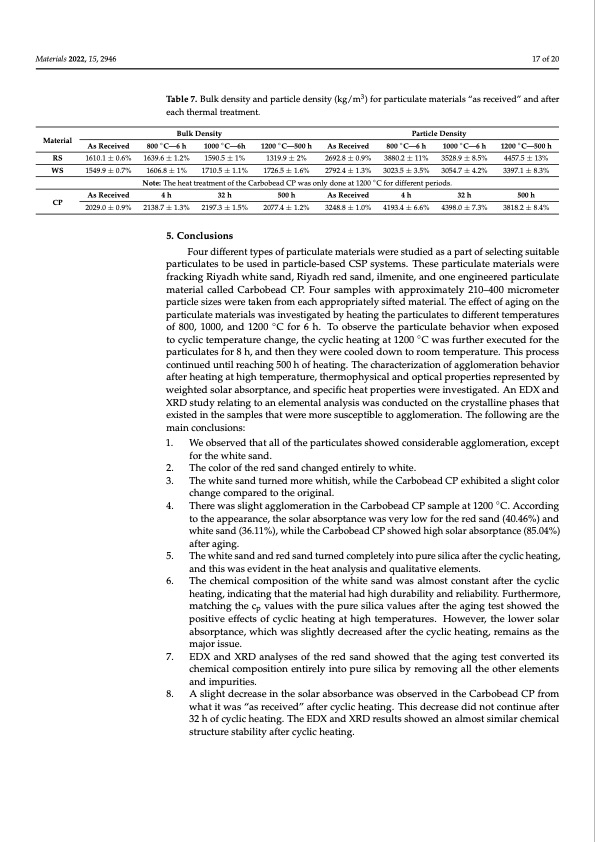
PDF Publication Title:
Text from PDF Page: 017
Materials 2022, 15, 2946 17 of 20 Material RS 1610.1 ± 0.6% Bulk Density 1000 ◦C—6h 1200 ◦C—500 h 1319.9 ± 2% 1726.5 ± 1.6% Particle Density 1000 ◦C—6 h 3528.9 ± 8.5% 3054.7 ± 4.2% 1200 ◦C—500 h 4457.5 ± 13% 3397.1 ± 8.3% 500 h 3818.2 ± 8.4% Table 7. Bulk density and particle density (kg/m3) for particulate materials “as received” and after each thermal treatment. As Received WS 1549.9 ± 0.7% 800 ◦C—6 h 1639.6 ± 1.2% 1606.8 ± 1% 1590.5 ± 1% 1710.5 ± 1.1% As Received 2692.8 ± 0.9% 800 ◦C—6 h 3880.2 ± 11% 3023.5 ± 3.5% CP As Received 2029.0 ± 0.9% 4 h 32 h 500 h As Received 4 h 32 h 2138.7 ± 1.3% 2197.3 ± 1.5% 2077.4 ± 1.2% 3248.8 ± 1.0% 4193.4 ± 6.6% 4398.0 ± 7.3% 5. Conclusions 2792.4 ± 1.3% Note: The heat treatment of the Carbobead CP was only done at 1200 ◦C for different periods. Four different types of particulate materials were studied as a part of selecting suitable particulates to be used in particle-based CSP systems. These particulate materials were fracking Riyadh white sand, Riyadh red sand, ilmenite, and one engineered particulate material called Carbobead CP. Four samples with approximately 210–400 micrometer particle sizes were taken from each appropriately sifted material. The effect of aging on the particulate materials was investigated by heating the particulates to different temperatures of 800, 1000, and 1200 ◦C for 6 h. To observe the particulate behavior when exposed to cyclic temperature change, the cyclic heating at 1200 ◦C was further executed for the particulates for 8 h, and then they were cooled down to room temperature. This process continued until reaching 500 h of heating. The characterization of agglomeration behavior after heating at high temperature, thermophysical and optical properties represented by weighted solar absorptance, and specific heat properties were investigated. An EDX and XRD study relating to an elemental analysis was conducted on the crystalline phases that existed in the samples that were more susceptible to agglomeration. The following are the main conclusions: 1. We observed that all of the particulates showed considerable agglomeration, except for the white sand. 2. The color of the red sand changed entirely to white. 3. The white sand turned more whitish, while the Carbobead CP exhibited a slight color change compared to the original. 4. There was slight agglomeration in the Carbobead CP sample at 1200 ◦C. According to the appearance, the solar absorptance was very low for the red sand (40.46%) and white sand (36.11%), while the Carbobead CP showed high solar absorptance (85.04%) after aging. 5. The white sand and red sand turned completely into pure silica after the cyclic heating, and this was evident in the heat analysis and qualitative elements. 6. The chemical composition of the white sand was almost constant after the cyclic heating, indicating that the material had high durability and reliability. Furthermore, matching the cp values with the pure silica values after the aging test showed the positive effects of cyclic heating at high temperatures. However, the lower solar absorptance, which was slightly decreased after the cyclic heating, remains as the major issue. 7. EDX and XRD analyses of the red sand showed that the aging test converted its chemical composition entirely into pure silica by removing all the other elements and impurities. 8. A slight decrease in the solar absorbance was observed in the Carbobead CP from what it was “as received” after cyclic heating. This decrease did not continue after 32 h of cyclic heating. The EDX and XRD results showed an almost similar chemical structure stability after cyclic heating.PDF Image | Low-Cost Particulates Used as Energy Storage and Heat-Transfer Medium

PDF Search Title:
Low-Cost Particulates Used as Energy Storage and Heat-Transfer MediumOriginal File Name Searched:
materials-15-02946.pdfDIY PDF Search: Google It | Yahoo | Bing
Turbine and System Plans CAD CAM: Special for this month, any plans are $10,000 for complete Cad/Cam blueprints. License is for one build. Try before you buy a production license. More Info
Waste Heat Power Technology: Organic Rankine Cycle uses waste heat to make electricity, shaft horsepower and cooling. More Info
All Turbine and System Products: Infinity Turbine ORD systems, turbine generator sets, build plans and more to use your waste heat from 30C to 100C. More Info
CO2 Phase Change Demonstrator: CO2 goes supercritical at 30 C. This is a experimental platform which you can use to demonstrate phase change with low heat. Includes integration area for small CO2 turbine, static generator, and more. This can also be used for a GTL Gas to Liquids experimental platform. More Info
Introducing the Infinity Turbine Products Infinity Turbine develops and builds systems for making power from waste heat. It also is working on innovative strategies for storing, making, and deploying energy. More Info
Need Strategy? Use our Consulting and analyst services Infinity Turbine LLC is pleased to announce its consulting and analyst services. We have worked in the renewable energy industry as a researcher, developing sales and markets, along with may inventions and innovations. More Info
Made in USA with Global Energy Millennial Web Engine These pages were made with the Global Energy Web PDF Engine using Filemaker (Claris) software.
Sand Battery Sand and Paraffin for TES Thermo Energy Storage More Info
| CONTACT TEL: 608-238-6001 Email: greg@infinityturbine.com | RSS | AMP |